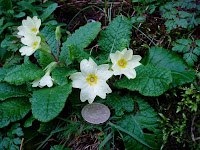A most pleasing aspect of my self-imposed mission to study the living things in my garden is that I am beginning to realise how much I have looked at things in the past, but over looked the fascinating details that are there before my eyes. I commented on this in my previous posting with regard to the shape of ivy leaves. My investigations of the primrose have led me to the 'discovery' that the flowers come in two distinct forms: 'pin' and 'thrum'. (I realise this will be this decidedly 'old news' to the botanists out there, but a delightful find for me).
 Photo 1 (click on it to enlarge) shows a primrose growing in my garden (at (0.5,0.9) - see here). This is a 'pin' plant, so-called because the stigma (the 'stalk thingy' right in the centre of the flower) sticks out like a pin. By contrast, photo 2 shows a 'thrum' (a lovely word I'm sure you'll agree. Apparently a term from weaving, meaning literally 'a tuft of thread') primrose. This one is not growing in my garden, but on a roadside verge a few hundred metres from my house.
Photo 1 (click on it to enlarge) shows a primrose growing in my garden (at (0.5,0.9) - see here). This is a 'pin' plant, so-called because the stigma (the 'stalk thingy' right in the centre of the flower) sticks out like a pin. By contrast, photo 2 shows a 'thrum' (a lovely word I'm sure you'll agree. Apparently a term from weaving, meaning literally 'a tuft of thread') primrose. This one is not growing in my garden, but on a roadside verge a few hundred metres from my house.Pin and thrum are apparently equally numerous in the primrose
 population. The flowers on any one plant are either all pin or all thrum. Furthermore, pin primroses cannot pollinate other pin's, or thrum's other thrum's: it takes a pin and a thrum to make a baby primrose! (It would be incorrect to think of either as 'male' or 'female' however - both are capable of 'giving birth' to fertile seeds).
population. The flowers on any one plant are either all pin or all thrum. Furthermore, pin primroses cannot pollinate other pin's, or thrum's other thrum's: it takes a pin and a thrum to make a baby primrose! (It would be incorrect to think of either as 'male' or 'female' however - both are capable of 'giving birth' to fertile seeds).From reading Primulas of the British Isles (J. Richards, publ. Shire Nat. Hist. 1989) I gather that the suggestion is that the benefit to primroses from all this heterostyly (literally "different styles") is that it guarantees that any one plant cannot self-pollinate: a plant requires pollen from its opposite (pin or thrum) type. Avoiding self-pollination presumably helps to keep the primrose gene pool healthy. Once again it seems a certain C. Darwin was historically involved in the debate (first robins, then goldfinches, now primroses - is there anything he didn't study!).
Another fascinating discovery for me is that primrose seeds come 'fitted' with an elaiosome. This is a fleshy 'lump' on the surface of the seed that is rich in proteins and designed to attract ants. Ants pick up the seeds and carry them away to their nests, eat the elaiosome and then 'dump' the left-over seed on a waste heap outside their nest. In this way the primrose gets its seeds not only distributed, but also planted on a nutrient rich site. I have seen plenty of TV documentaries over the years, showing strange insects in far-away jungles engaged in complex acts of partnership with exotic plants. I find it wonderful to think however, that there equally delicate 'waltzes' going on between the creatures in my garden. I am determined to have a look for ants around my primrose in the summer!
To end, a little Shakespeare? But of course, though I cannot promise a cheery quote:
Porter: I had thought to have let in some of
all professions that go the primrose way to the everlasting bonfire.
(Macbeth, Act III, Scence III)
2 comments:
For More about Primulas:
www.sunfarm.com
I am also a gardener and I have an online shop where I sell seeds. Do visit my page and buy some seeds of different flowers and vegetables. I have a huge variety.
Post a Comment